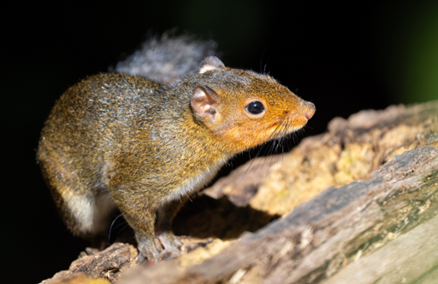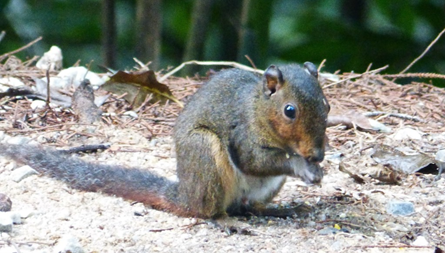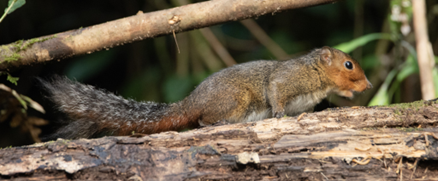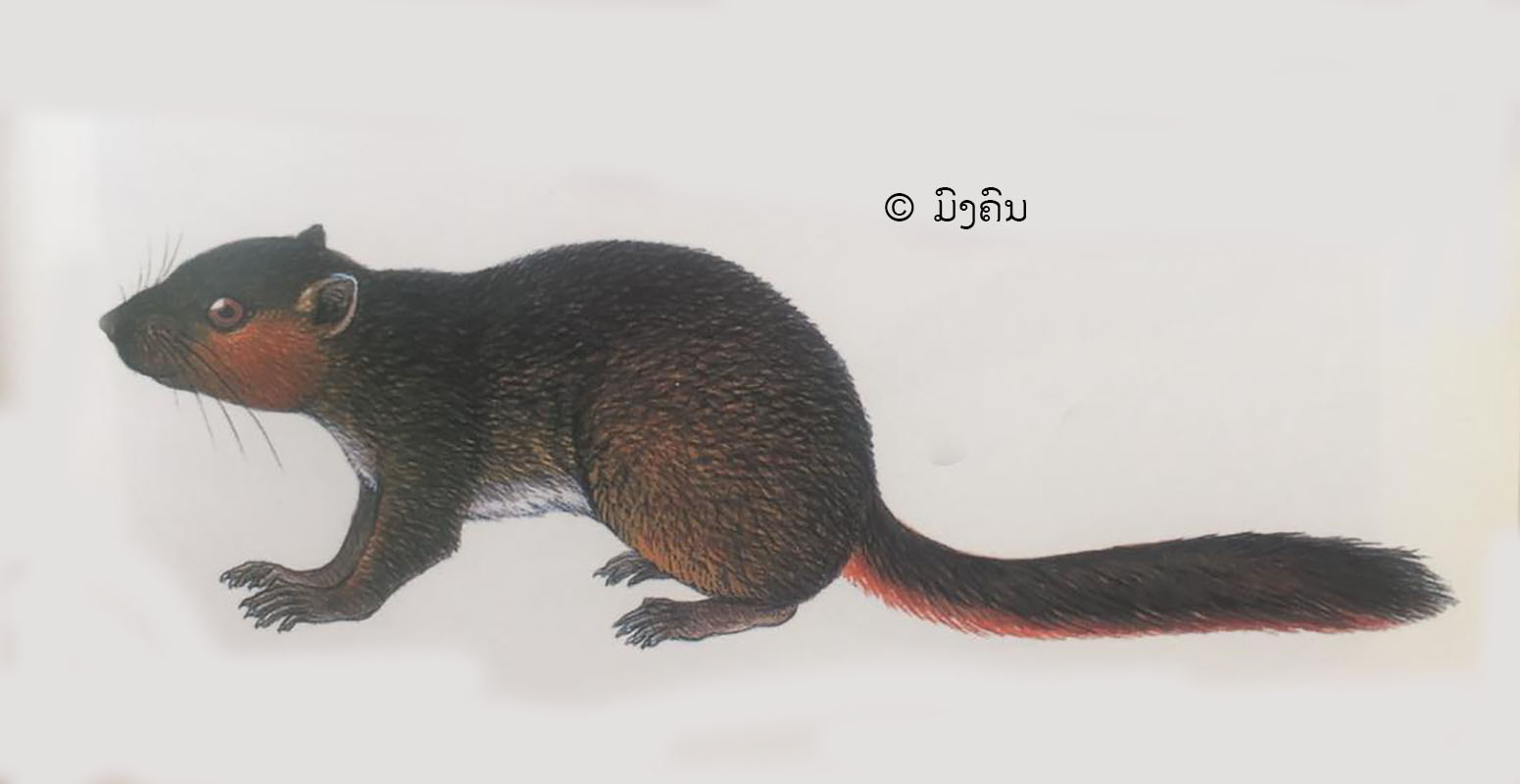ເລກລຳດັບທີ: 3618
ລະດັບການຮວບຮວມຂໍ້ມູນ: ຂໍ້ມູນພື້ນຖານ
ປັບປູງຄັ້ງລ່າສຸດ: 2024-10-19
ກະຮອກແກ້ມແດງ
Red-cheeked Squirrel
Dremomys rufigenis (Blanford, 1878)
ສັດ
ສັດລ້ຽງລູກດ້ວຍນົມ
×
ຊື່ທ້ອງຖີ່ນ:
ພຣອກ ປອມຢິມ (ກຶມມຸ) ( Asian red-cheeked squirrel, Ardilla de mejillas rojas, Echtes Rotwangenhérnchen, Ecureuil a joues rousses, Red-cheeked Squirrel)
ຊື່ພ້ອງ
:
Dremomys rufigenis subsp. adamsoni Thomas 1914
Dremomys rufigenis subsp. belfieldi (Bonhote, 1908)
Dremomys rufigenis subsp. fuscus (Bonhote, 1907)
Dremomys rufigenis subsp. ornatus Thomas, 1914
Dremomys rufigenis subsp. belfieldi (Bonhote, 1908)
Dremomys rufigenis subsp. fuscus (Bonhote, 1907)
Dremomys rufigenis subsp. ornatus Thomas, 1914
ຊື່ສະກຸນ:
Sciuridae
ຊະນິດໃກ້ຄຽງ:
ບັນຍາຍລັກສະນະທາງພືດສາດ:
ຫົວ ແລະ ລໍາຕົວຍາວ: 18 ຊມ. ຫາງຍາວ: 16 ຊມ. ເປັນກະຮອກນ້ອຍ, ຂົນເຂດຫົວ, ເຂດເລົາຄີງສ່ວນເທິງ ແລະ ເຂດຂາສ່ວນເທິງມີສີນ້ຳຕານໄໝ້ຂົນຄາງມີສີແດງເຂັ້ມ ຫຼື ສີສົ້ມ, ທ້ອງຫາງດ້ານຂ້າງມີສີນ້ຳຕານແກມແດງ, ດ້ານຫຼັງຂອງຫາງມີສີນ້ຳຕານໄໝ້, ສ່ວນເຂດທີ່ມີຂົນຍາວສີຂາວ, ໝອກປົກຄຸມສີດຳ, ເຂດເອິກ ແລະ ທ້ອງມີສີຂາວ, ໂດຍປົກກະຕິຈະມີຈຸດສີຂາວນ້ອຍໆຢູ່ເບື້ອງຫຼັງຂອງຫູ, ດັງມີລັກສະນະຍາວ ແລະ ແໝບກວ່າກະຮອກຊະນິດອື່ນໆຂອງລາວ. ອຸປະນິໄສ: ເປັນສັດທີ່ຫາກິນຢູ່ຕາມຊັ້ນຕ່າງໆຂອງປ່າ ແລະ ຕາມດິນ, ຫາກິນຢູ່ຕາມໃບໄມ້ ຫຼື ເຂດໃກ້ໆກັບພື້ນດິນ ແຕ່ບາງຄັ້ງຄາວພວກມັນສາມາດຫາກິນໝາກໄມ້ຕາມປາຍໄມ້, ນອກນັ້ນພວກມັນຍັງກິນແມງໄມ້, ຮາກໄມ້ ແລະ ສ່ວນອື່ນໆຂອງພືດເປັນອາຫານອີກດ້ວຍ. ສຽງຮ້ອງ: ? ຖິ່ນອາໄສ: ອາໄສຢູ່ປ່າດົງດິບ ແລະ ປ່າປ່ຽນໃບ ຈາກທົ່ງພຽງແຄມນ້ຳຂອງຈົນເຖິງເຂດພູສູງ, ກະຮອກຊະນິດດັ່ງກ່າວເປັນສັດທົ່ວໄປຂອງຫຼາຍທ້ອງຖິ່ນໃນເຂດທົ່ງພຽງ.
ນິເວດວິທະຍາ
ເຂດກະຈາຍພັນທົ່ວໂລກ:
Native to China, India, Laos, Malaysia, Myanmar, Thailand and Viet Nam
Source: [6]
Source: [6]
ເຂດກະຈາຍພັນໃນລາວ
:
ເຂດພູສູງພາກເໜືອຂອງລາວ
ລຽບແມ່ນ້ຳຂອງພາກເໜືອ
ເຂດພູສູງສາຍພູຫຼວງ ແລະ ເຂດພູພຽງແຂວງຊຽງຂວາງ
ທົ່ງພຽງວຽງຈັນ
ເຂດສາຍພູຫຼວງພາກເໜືອ
ເຂດສາຍພູຫຼວງຕອນລຸ່ມ
ພູພຽງບໍລິເວນ
ເຂດສາຍພູຫຼວງພາກກາງ
ລຽບແມ່ນ້ຳຂອງພາກເໜືອ
ເຂດພູສູງສາຍພູຫຼວງ ແລະ ເຂດພູພຽງແຂວງຊຽງຂວາງ
ທົ່ງພຽງວຽງຈັນ
ເຂດສາຍພູຫຼວງພາກເໜືອ
ເຂດສາຍພູຫຼວງຕອນລຸ່ມ
ພູພຽງບໍລິເວນ
ເຂດສາຍພູຫຼວງພາກກາງ

ເຂດກະຈາຍພັນຕາມພູມສັນຖານ
:
ປ່າດົງດິບ
ປ່າປູກ
ເຂດຜະລິດພືດຜົນເນີນສູງ
ປ່າປູກ
ເຂດຜະລິດພືດຜົນເນີນສູງ
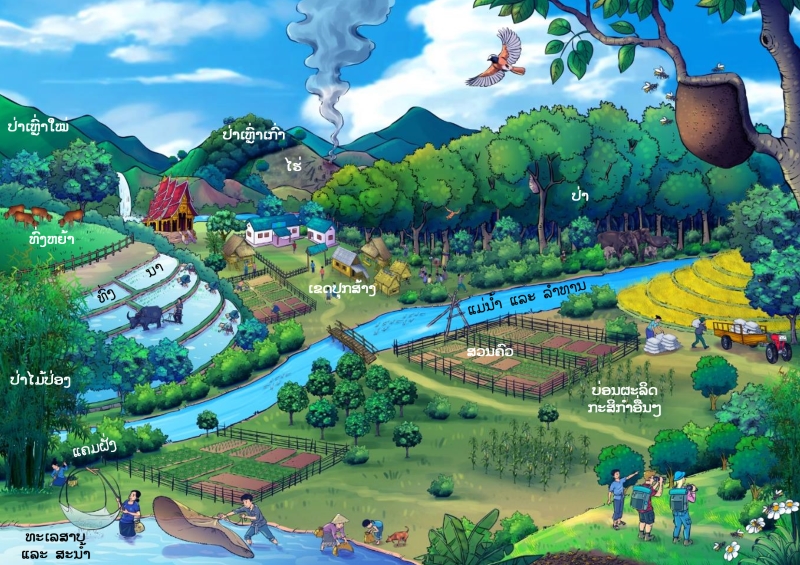
ສະເພາະຖິ່ນໃນລາວ:
ພື້ນເມືອງ
ຮຸກຮານ
:
ບໍ່ຮຸກຮານ
ສະຖານະພາບການອະນູຮັກ IUCN
:
ມີຄວາມສ່ຽງໜ້ອຍສຸດ
ສະຖານະພາບການອະນຸຮັກແຫ່ງຊາດລາວ
:
ບັນຊີທີ່ III: ຊະນິດພັນປະເພດທົ່ວໄປ
ການນຳໃຊ້
ປະເພດການນຳໃຊ້:
ອາຫານ
ບັນຍາຍການນຳໃຊ້:
ການປູກ ການລ້ຽງ:
ຊະນິດທຳມະຊາດ
ລະດູການເກັບກູ້:
ມັງກອນ
ກຸມພາ
ມີນາ
ເມສາ
ພຶກສະພາ
ມິຖຸນາ
ທັນວາ
ກຸມພາ
ມີນາ
ເມສາ
ພຶກສະພາ
ມິຖຸນາ
ທັນວາ
ການຕະຫຼາດ ແລະ ຕ່ອງໂສ້ມູນຄ່າ:
N/A
ການຄຸ້ມຄອງຈັດການ
N/A
ໂພຊະນາການ
ຄຸນຄ່າທາງໂພຊະນາການ:
ແຫຼ່ງໂປຣຕີນທີ່ສຳຄັນ
ບັນຍາຍຄຸນຄ່າທາງໂພຊະນາການ:
N/A
| ສານອາຫານ | /100g | ໝາຍເຫດ |
|---|---|---|
| ໂປຣຕີນ | N/A | N/A |
| ຄາໂບໄຮເດຣດ | N/A | N/A |
| ໄຂມັນ | N/A | N/A |
| ວິຕາມິນ | N/A | N/A |
| ແຮ່ທາດ | N/A | N/A |
| ເສັ້ນໄຍ | N/A | N/A |
ອ້າງອິງ
ເຄດິດຮູບພາບ:
Red-cheeked squirrel up close. [1] iNaturalist [Online]. Uploaded on 25 May 2024 by: tiluchi. Available: www.inaturalist.org/observations/218029809. [Accessed: 11 October 2024]
Red-cheeked squirrel eating. [2] iNaturalist [Online]. Uploaded on 14 may 2019 by Lena Chow. Available: https://inaturalist.nz/photos/39326546. [Accessed: 16 August 2024]
Red-cheeked squirrel on a tree. [3] iNaturalist [Online]. Uploaded on 19 April 2024 by: sergeyyeliseev. Available: www.inaturalist.org/observations/208067140. [Accessed: 11 October 2024]
Red-cheeked squirrel eating. [2] iNaturalist [Online]. Uploaded on 14 may 2019 by Lena Chow. Available: https://inaturalist.nz/photos/39326546. [Accessed: 16 August 2024]
Red-cheeked squirrel on a tree. [3] iNaturalist [Online]. Uploaded on 19 April 2024 by: sergeyyeliseev. Available: www.inaturalist.org/observations/208067140. [Accessed: 11 October 2024]
ອ້າງອິງ:
[1] GBIF [Online]. Uploaded on 25 February 2024 by Peter Kennerley. Available: https://www.gbif.org/occurrence/4847237040. [Accessed: 16.08.2024]
[2] iNaturalist [Online]. Uploaded on 14 may 2019 by Lena Chow. Availa-ble: https://inaturalist.nz/photos/39326546. [Accessed: 16.08.2024]
[3] GBIF [Online]. Uploaded on 6 May 2024 by Forest Botial-Jarvis. Avail-able: https://www.gbif.org/occurrence/4872599158. [Accessed: 16.08.2024]
[4] D. Prathumtong and A. P. Khlaipet, Mammals of Natural world herit-age “Thung Yai Naresuan – Huai Kha Khaeng”. Pahum Thani: National Science Museum Thailand. 2022
[5] C. Francis. A Guide to the Mammals of Southeast Asia. Princeton: Princeton University Press. 2008
[6] IUCN. (2017 January 11). IUCN red list. Retrieved from IUCN red list web site: https://www.iucnredlist.org/species/6824/22256057
[2] iNaturalist [Online]. Uploaded on 14 may 2019 by Lena Chow. Availa-ble: https://inaturalist.nz/photos/39326546. [Accessed: 16.08.2024]
[3] GBIF [Online]. Uploaded on 6 May 2024 by Forest Botial-Jarvis. Avail-able: https://www.gbif.org/occurrence/4872599158. [Accessed: 16.08.2024]
[4] D. Prathumtong and A. P. Khlaipet, Mammals of Natural world herit-age “Thung Yai Naresuan – Huai Kha Khaeng”. Pahum Thani: National Science Museum Thailand. 2022
[5] C. Francis. A Guide to the Mammals of Southeast Asia. Princeton: Princeton University Press. 2008
[6] IUCN. (2017 January 11). IUCN red list. Retrieved from IUCN red list web site: https://www.iucnredlist.org/species/6824/22256057
ຜູ້ສ້າງ Factsheet:
ຜູ້ກວດສອບ Factsheet:
,
